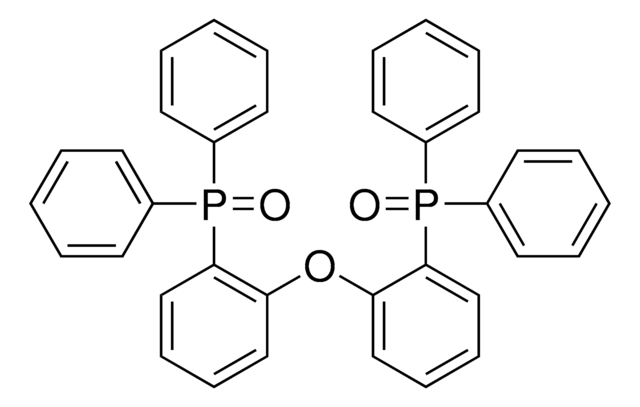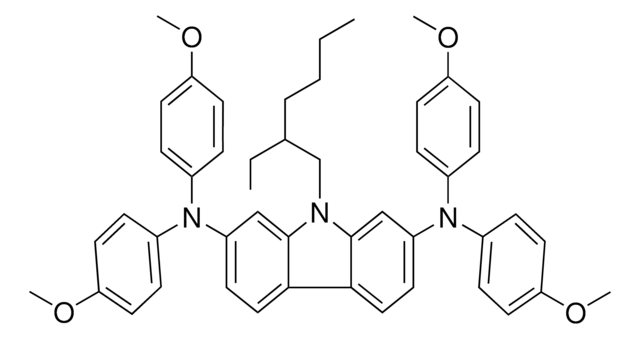907073
PO-T2T
>=99% (HPLC), Mw 909.8 g/mol,
Synonyme(s) :
(1,3,5-Triazine-2,4,6-triyl)tris(benzene-3,1-diyl)tris(diphenylphosphine oxide), 2,4,6-Tris[3-(diphenylphosphinyl)phenyl]-1,3,5-triazine
About This Item
Produits recommandés
Nom du produit
PO-T2T, >=99% (HPLC),
Qualité
sublimed grade (>99% (HPLC))
Description
PL-295, 379 nm (in CH2Cl2)
Forme
solid
Poids mol.
Mw 909.8 g/mol
Couleur
white
λmax
272 nm in dichloromethane
Énergie orbitale
HOMO -6.8 eV
LUMO -2.8 eV
Température de stockage
15-25°C
Chaîne SMILES
[P](=O)(c3cc(ccc3)c4nc(nc(n4)c8cc(ccc8)[P](=O)(c%10ccccc%10)c9ccccc9)c5cc(ccc5)[P](=O)(c7ccccc7)c6ccccc6)(c2ccccc2)c1ccccc1
Clé InChI
RDVGOMWIWCMKAM-UHFFFAOYSA-N
Application
ITO/MoO3 (3 nm)/ TAPC (35 nm)/CBP:TTM-3NCz (3.0 wt%; (40 nm) and CBP:TTM3PCz (3.0 wt%; 25 nm)/B3PYMPM (10 nm)/PO-T2T (70 nm)/LiF (0.8 nm)/Al (100 nm).
The first Tandem, All-exciplex-based WOLED was constructed using PO-T2T for a device structure configured by two parallel blend layers of mCP/PO-T2T and DTAF/PO-T2T, generating blue and yellow exciplex emission, respectively. The resulting device demonstrates for the first time a tandem, all-exciplex-based white-light OLED (WOLED) with excellent efficiencies ηext: 11.6%, ηc: 27.7 cd/A, and ηp: 15.8 ml/W with CIE(0.29, 0.35) and CRI 70.6 that are nearly independent of EL intensity. The tandem architecture and blend-layer donor/acceptor (1:1) configuration are two key elements that fully utilize the exciplex delay fluorescence, providing a paragon for the use of low-cost, abundant organic compounds en route to commercial WOLEDs.
An efficient action of radical-based OLEDs, whose emission originates from a spin doublet, rather than a singlet or triplet exciton was demonstrated in a study published in Nature.
While the emission process is still spin-allowed in these OLEDs, the efficiency limitations imposed by triplet excitons are circumvented for doublets. Using a luminescent radical emitter, an OLED with maximum external quantum efficiency of 27% at a wavelength of 710nm-the highest reported value for deep-red and infrared LEDs was achieved. In this very efficient OLEDs, selective hole injection into the HOMO and electron injection to the SOMO was achieved imploying TAPC as the hole transport layer, and PO-T2T as the electron transport layer to form the fluorescent doublet excited state with near-unity internal quantum efficiency.
Code de la classe de stockage
13 - Non Combustible Solids
Classe de danger pour l'eau (WGK)
WGK 3
Point d'éclair (°F)
Not applicable
Point d'éclair (°C)
Not applicable
Faites votre choix parmi les versions les plus récentes :
Certificats d'analyse (COA)
Vous ne trouvez pas la bonne version ?
Si vous avez besoin d'une version particulière, vous pouvez rechercher un certificat spécifique par le numéro de lot.
Déjà en possession de ce produit ?
Retrouvez la documentation relative aux produits que vous avez récemment achetés dans la Bibliothèque de documents.
Articles
Professor Tokito and Professor Takeda share their new materials, device architecture design principles, and performance optimization protocols for printed and solution-processed, low-cost, highly flexible, organic electronic devices.
Notre équipe de scientifiques dispose d'une expérience dans tous les secteurs de la recherche, notamment en sciences de la vie, science des matériaux, synthèse chimique, chromatographie, analyse et dans de nombreux autres domaines..
Contacter notre Service technique








